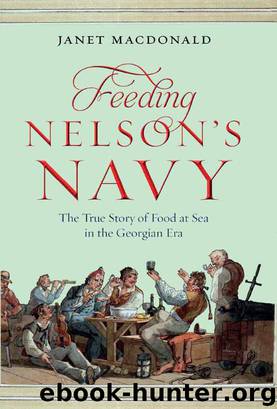Feeding Nelson's Navy by Janet Macdonald

Author:Janet Macdonald
Language: eng
Format: epub
Publisher: Frontline Books
Published: 2014-12-08T16:00:00+00:00
TIMING OF MEALS
Although theoretically the time and duration of meals was at the captain’s discretion, when a squadron was working together such things were laid down by the senior officer. Sir Edward Pellew took over the East Indies squadron in 1805 and put out a general order that said ‘The commander-in-chief…will hoist a red pennant at the main when he makes it noon, that all the crews may dine at the same time… [they] are to breakfast at eight bells [in this case, 8am] and sup at half past five pm.’ This makes good sense: a commanding officer who is contemplating mass manoeuvres wants people available to perform them and since mealtimes were sacrosanct he would want to know when they were. The norm was forty-five minutes each for breakfast and supper and an hour and a half for dinner.17 Pellew stated this and went on to say that ‘the meal times of the people are not [to be] broken in upon’; Nelson remarked in one of his general orders about turning the men up for muster when demanded by the senior officer at a port ‘meal times excepted’, and many captains said much the same in their own order books.18 So we can accept that with the exception of essential watch-keepers such as lookouts or steersmen, who were known as ‘seven-bell men’ because they ate half an hour early, all the crew (ie everyone except the officers) ate together. Mealtimes were piped by the boatswain.
At this point one begins to wonder whether they ate their meat dinners hot. This doubt comes from contemplating the length of time it would take for the meat to cook, and the time it would take the cook and his assistants to serve each mess cook. Obviously this varied according to the size of the ship and the number in her crew – a large ship bearing less than her full complement having less of a problem than one which mustered nearly 100 per cent of her complement – but since we do have some actual figures for Victory, we will continue to use her as an example. During the first year when Nelson had her as his flagship in the Mediterranean July 1803 to June 1804) she was carrying an average of 811 men, so although the officers would not be eating from the main boilers we can say that roughly 800 were. Whether there were still 165 messes, as five years previously, is not known, but it seems likely. On a pork day one boiler would contain pork, the other pease; on a beef day one beef and the other vegetables or pudding. We can say that with fair conviction because the pease, vegetables and pudding would not take as long as the meat to cook and would anyway be awkward to cook in the same pot. Even so, the boilers were going to be pretty full of nets and bags, each of which had to be given to the right mess at serving time.
Download
This site does not store any files on its server. We only index and link to content provided by other sites. Please contact the content providers to delete copyright contents if any and email us, we'll remove relevant links or contents immediately.
| Automotive | Engineering |
| Transportation |
Whiskies Galore by Ian Buxton(41531)
Introduction to Aircraft Design (Cambridge Aerospace Series) by John P. Fielding(32889)
Small Unmanned Fixed-wing Aircraft Design by Andrew J. Keane Andras Sobester James P. Scanlan & András Sóbester & James P. Scanlan(32573)
Craft Beer for the Homebrewer by Michael Agnew(17933)
Turbulence by E. J. Noyes(7700)
The Complete Stick Figure Physics Tutorials by Allen Sarah(7141)
Kaplan MCAT General Chemistry Review by Kaplan(6595)
The Thirst by Nesbo Jo(6437)
Bad Blood by John Carreyrou(6277)
Modelling of Convective Heat and Mass Transfer in Rotating Flows by Igor V. Shevchuk(6223)
Learning SQL by Alan Beaulieu(6035)
Weapons of Math Destruction by Cathy O'Neil(5829)
Man-made Catastrophes and Risk Information Concealment by Dmitry Chernov & Didier Sornette(5649)
Digital Minimalism by Cal Newport;(5389)
Life 3.0: Being Human in the Age of Artificial Intelligence by Tegmark Max(5184)
iGen by Jean M. Twenge(5162)
Secrets of Antigravity Propulsion: Tesla, UFOs, and Classified Aerospace Technology by Ph.D. Paul A. Laviolette(4992)
Design of Trajectory Optimization Approach for Space Maneuver Vehicle Skip Entry Problems by Runqi Chai & Al Savvaris & Antonios Tsourdos & Senchun Chai(4841)
Electronic Devices & Circuits by Jacob Millman & Christos C. Halkias(4748)
